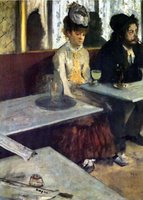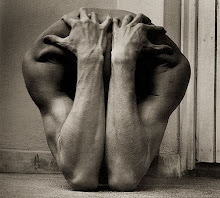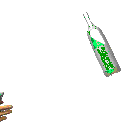WHAT IS ABSINTHE?
And what does it have to do with New Orleans?
Absinthe is a strong herbal liqueur distilled with a great number of flavorful herbs like anise, licorice, hyssop, veronica, fennel, lemon balm, angelica and wormwood (the flavor of anise and/or licorice, at least in contemporary forms of the liquor, tends to predominate). Wormwood, the one that's gained the most notoriety, is Artemisia absinthum, an herb that grows wild in Europe and has been cultivated in the United States as well. Much of the liquor's legendary effect is due to its extremely high alcohol content, ranging from 50% to 75% (usually around 60%), plus the contribution of the various herbs. It has been assumed by many that the so-called "active ingredient" in absinthe is wormwood, although that is apparently not really the case.
It was traditionally served with ice water and a cube of sugar; the sugar cube was placed on a slotted "absinthe spoon", and the water was drizzled over the sugar into the glass of absinthe (typically in a 3:1 or 4:1 ratio). The sugar helped take the bitter edge from the absinthe, and when the water is drizzled into the the liquor it all turns milky greenish-white (the effect is called "louche").
The drink was referred to in France as "La Fée Verte", or The Green Fairy, which is a reference to its often dazzling green color (depending on the brand). The color usually came from the chlorophyll content of the herbs used in the distillation process; however, some disreputable manufacturers added toxic chemicals to produce both the green color and the louche (or clouding) effect that in reputable brands was caused by the precipitation of the essential oils of the herbs. It is quite probable that the bad reputation absinthe developed was due to these low-grade and perhaps quite poisonous version of the real thing.
Wormwood had been used medicinally since the Middle Ages, primarily to exterminate tapeworm infestations while leaving the human host uninjured and even rejuvenated by the experience. At the end of the 18th century -- the age of revolution and skeptical humanism -- the herb developed a recreational vogue. People discovered they could get high off it. The problem was the means of delivery, as it was unacceptably bitter in taste.
A French expatriate living in Switzerland by the name of Dr. Ordinaire found the answer by inventing absinthe, which delivered both the herb and alcohol in a stunningly tart beverage, with a flavor resembling licorice. The most well-known maker of absinthe was French distiller Henri-Louis Pernod, who was impressed with Dr. Ordinaire's beverages and purchased the secrets of its distillation and manufacture. Absinthe would eventually enjoy its greatest popularity in fin-de-siècle Paris, with Vincent Van Gogh, Paul Verlaine, Alfred Jarry and Oscar Wilde among its most ardent imbibers.
Given the French character of the Crescent City, absinthe achieved quite a bit of popularity in New Orleans as well, where it was widely consumed by people from artists to musicians to Storyville madams. Visitors to New Orleans can still check out the beautiful, ornate spigot at the Old Absinthe House bar on Bourbon Street; it was used to drip cold water over the sugar into the beverage. (Note: I haven't been to that bar in a while, but I understand it was recently sold and gutted; I'm not sure the original spigot is still there.)
Around the turn of the century, after observing a subset of alcoholism referred to as "absinthism", and noting that heavy absinthe users had a propensity toward madness and suicide, by the second decade of this century it became banned in the Western world, unfairly lumped in with opiates, cocaine, and marijuana when it is, in fact, just another alcoholic beverage (although one with unique properties). Although the effects of thujone can be toxic when consumed in very large quantities, this substance is found in properly made and distilled absinthe in only the smallest trace amounts. The most popular misconception about absinthe is that it is a drug. "Not so!" says the Fée Verte FAQ. As for the so-called "secondary effect", we refer you again to the FAQ:
[Q]uality absinthe, properly distilled, does have a different effect over and above the results of alcohol, though at up to 70%, the effects of the alcohol alone can be considerable. Absinthe's effects, despite popular conception, are not due to the wormwood (Artemisia Absinthia) alone. Absinthe's constituents consist of a very delicate balance of various herbs, most of which contribute in one way or another to its intoxicating effects. [Chemist and absinthe expert] Ted Breaux once explained it that it is a push-me, pull-you effect of the various herbs, as some are of an heightening effect, and others are lowering. The effect on the individual is subjective, and can best be described as a kind of heightened clarity of mind and vision, mildly ponderous and sparkling, and warmed by the effect of the alcohol. This seems to wear off after 20 or 30 minutes, leaving one with an alcohol buzz. 2-3 glasses seems to do the trick. More than that, depending on the proof of the alcohol, will just make you very drunk. But saying all that, 'secondary effects' seem to be quite subjective. Some have never felt them at all. Some say one brand works for them, others another. Many absintheurs ... have placed absinthe's 'effects' low on their priority list when it comes to judging modern commercial absinthes, preferring to focus on actual herbal constituents, manufacture and historical detail.















 Hippocrates recommended absinthe for juandice and rheumatism. Ancient absinthe was different from the liquor that Verlaine and Picasso imbibed, generally being wormwood leaves soaked in wine or spirits. Most likely the word absinthe derives from the Greek word apsinthion, which means " undrinkable " presumably because of its bitter taste. Pythagoras recommended wormwood soaked in wine to aid labor in childbirth. Hippocrates prescribed it for jaundice, rheumatism, anemia, and menstrual pains. The Roman scholar Pliny the Elder called it apsinthium in the first century A.D. and noted that it was customary for the champion in chariot races to drink a cup of absinthe leaves soaked in wine to remind him that even glory has its bitter side. He also recommended it as an elixir of youth and as a cure for bad breath... Over the centuries, however, wormwood drinks moved away from being just bitter medicine. Independent distilleries were producing absinthe made from the dried leaves of wormwood steeped in equal parts of malmsey wine and " burning water thrice distilled." The " Purl " of Tudor England was compounded of ale or hot beer and wormwood, and although it was mainly popular with the working classes, Samuel Pepys reported in his famous diary that he had enjoyed several glasses of wormwood ale one night " in a little house...which doubtless was a bawdy house." These dusty tales convey something of the mystique surrounding absinthe; one imagines a flask of it sitting beside the alchemist's crocodile and the mandrake root. Absinthe incorporated Olympian legends of debauch and rather downhome peasant notions. Modern absinthe allegedly was invented in 1792 by an extraordinary French doctor called Pierre Ordinaire, who fled France's revolution to settle in Couvet, a small village in western Switzerland. On his periodic journeys by horseback, Dr. Ordinaire is said to have discovered the plant Artemisia absinthium growing wild in the hills of the Val-de-Travers region. Like most country doctors, he prepared his own remedies, and being acquainted with absinthe's use in ancient times, he began experimenting with it.
Hippocrates recommended absinthe for juandice and rheumatism. Ancient absinthe was different from the liquor that Verlaine and Picasso imbibed, generally being wormwood leaves soaked in wine or spirits. Most likely the word absinthe derives from the Greek word apsinthion, which means " undrinkable " presumably because of its bitter taste. Pythagoras recommended wormwood soaked in wine to aid labor in childbirth. Hippocrates prescribed it for jaundice, rheumatism, anemia, and menstrual pains. The Roman scholar Pliny the Elder called it apsinthium in the first century A.D. and noted that it was customary for the champion in chariot races to drink a cup of absinthe leaves soaked in wine to remind him that even glory has its bitter side. He also recommended it as an elixir of youth and as a cure for bad breath... Over the centuries, however, wormwood drinks moved away from being just bitter medicine. Independent distilleries were producing absinthe made from the dried leaves of wormwood steeped in equal parts of malmsey wine and " burning water thrice distilled." The " Purl " of Tudor England was compounded of ale or hot beer and wormwood, and although it was mainly popular with the working classes, Samuel Pepys reported in his famous diary that he had enjoyed several glasses of wormwood ale one night " in a little house...which doubtless was a bawdy house." These dusty tales convey something of the mystique surrounding absinthe; one imagines a flask of it sitting beside the alchemist's crocodile and the mandrake root. Absinthe incorporated Olympian legends of debauch and rather downhome peasant notions. Modern absinthe allegedly was invented in 1792 by an extraordinary French doctor called Pierre Ordinaire, who fled France's revolution to settle in Couvet, a small village in western Switzerland. On his periodic journeys by horseback, Dr. Ordinaire is said to have discovered the plant Artemisia absinthium growing wild in the hills of the Val-de-Travers region. Like most country doctors, he prepared his own remedies, and being acquainted with absinthe's use in ancient times, he began experimenting with it.  Dr. Ordinaire's recipe probably included the following herbs: wormwood, anise (Pimpinella anisum), hyssop (Hyssopus officinalis), dittany (Dictamnus albus), sweet flag (Acorus calamus), Melissa (a type of mint), and varying amounts of coriander, veronica, chamomile, parsley, and even spinach. The 136 proof elixir produced in his sixteen liter still became popular as a cure-all in town and early on was nicknamed La Fée Verte. On his death, he supposedly left his secret recipe to two Henriod sisters from Couvet, who then left it to a visiting Frenchman, Major Dubied, whose son-in-law was named Pernod, and the rest is history.
Dr. Ordinaire's recipe probably included the following herbs: wormwood, anise (Pimpinella anisum), hyssop (Hyssopus officinalis), dittany (Dictamnus albus), sweet flag (Acorus calamus), Melissa (a type of mint), and varying amounts of coriander, veronica, chamomile, parsley, and even spinach. The 136 proof elixir produced in his sixteen liter still became popular as a cure-all in town and early on was nicknamed La Fée Verte. On his death, he supposedly left his secret recipe to two Henriod sisters from Couvet, who then left it to a visiting Frenchman, Major Dubied, whose son-in-law was named Pernod, and the rest is history.

 ERNEST HEMINGWAY (1899-1961)
ERNEST HEMINGWAY (1899-1961) ALFRED JARRY (1873-1907)
ALFRED JARRY (1873-1907) ARTHUR RIMBAUD (1855-1891)
ARTHUR RIMBAUD (1855-1891)











